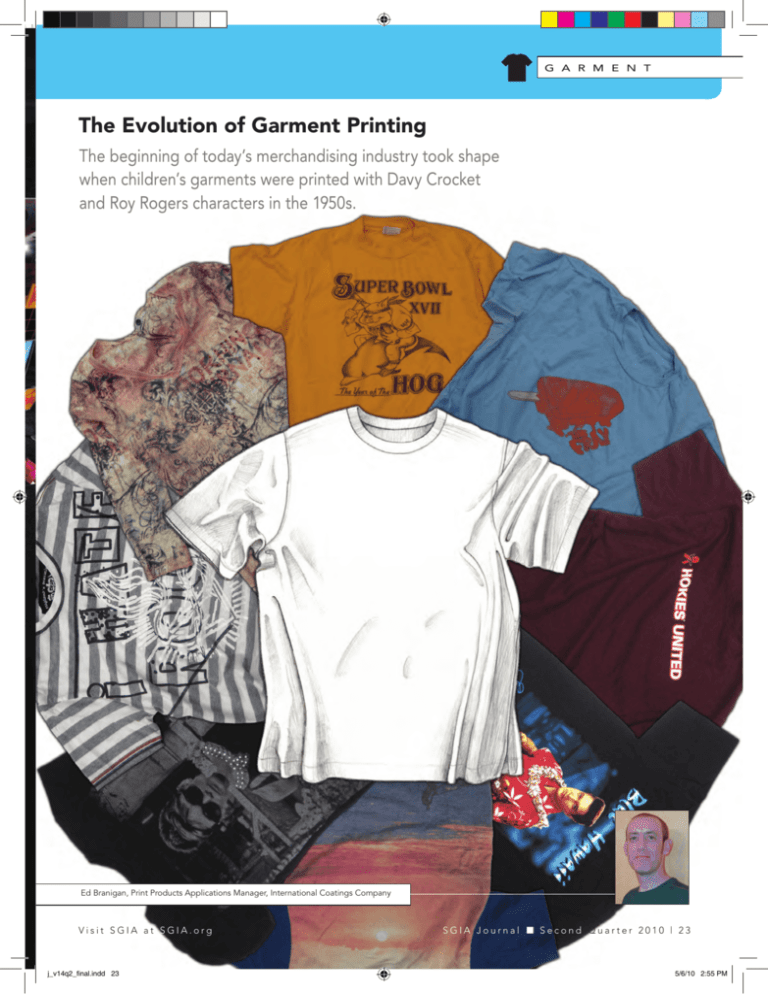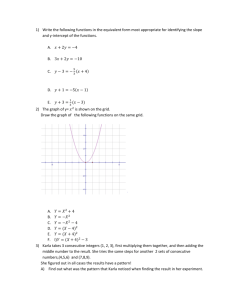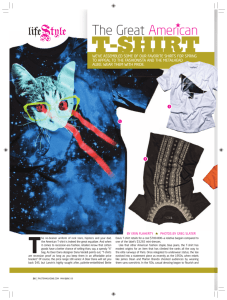The Evolution of Garment Printing
advertisement

S af e t y ga r m e n t The Evolution of Garment Printing The beginning of today’s merchandising industry took shape when children’s garments were printed with Davy Crocket and Roy Rogers characters in the 1950s. Ed Branigan, Print Products Applications Manager, International Coatings Company Visit SGIA at SGIA.org j_v14q2_final.indd 23 SGIA Journal ■ Second Quarter 2010 | 23 5/6/10 2:55 PM The birth of plastics, first synthesized in the mid 1800s, was critical in manufacturers’ ability to print directly on garments on a mass scale. The T-shirt’s journey from underwear to outerwear to a vehicle of personal artistic expression took almost 60 years and is still evolving. When and where the first imprinted T-shirts appeared in mass produced form is not easily definable. Key dates indicating changes in technology helped spur its development along with key personalities. For example, when the T-shirt made its first foray to the outside world, Clark Gable sent it back to the bedroom. It was then rescued by Marlon Brando and cemented into place by Andy Warhol. Rise of the T-Shirt Andy Warhol is credited for popularizing screen printing in the US. His first oneman show as a fine artist in 1962 included the famous portrait of Marilyn Monroe printed with loud, bright colors and were not “perfect prints.” The registration was slightly off and ink splotches on some were not removed. Screen printing, or serigraphy, had been used by fine artists for many years before Warhol’s show. What made the difference was Warhol’s attitude and subject matter. He opened the door and gave permission to the regular guy to 24 | SGIA Journal ■ Second Quarter 2010 j_v14q2_final.indd 24 make his own art and showed him a way to do it. Warhol’s ascent in the art world and popular culture was prescient because popular culture was on the cusp of momentous change and the T-shirt’s place in that culture was solidifying. Both arrived at the crossroads at the same time. Until World War I, the T-shirt did not exist in America as we know it today. It was an undershirt that never saw the light of day. Most people wore undergarments made from a heavier, woolen fabric. No one knows when the first T-shirt was actually made, but sailors returning from France after World War I left behind their heavy, long-sleeved woolen undershirts and brought back the lightweight knit cotton undershirts favored by Europeans. These shirts did not necessarily resemble the T-shirt we know today; they were still underwear, most commonly sleeveless and primarily worn for comfort. The appearance of central heating coincided with this new movement, and by the late 1920s and early 1930s, people began wearing lighter two-piece undergarments instead of long johns. During the 1930s, many working men wore these sleeveless cotton shirts as undergarments, and during this time, the T-shirt made its first forays into the outside world. In the 1930s, Fruit of the Loom, Hanes and Sears began marketing T-shirts. However, when Clark Gable took off his shirt in the 1934 movie “It Happened One Night” to reveal his bare chest, men discarded their undershirts in droves. The T-shirt all but disappeared. Some time later, the US Army and Marines issued standard T-shirts with arms that were more popular due to their appearance and greater comfort. But, it Visit SGIA at SGIA.org 5/6/10 2:55 PM was Marlon Brando as the undershirtwearing Stanley Kowalski in the 1951 movie “A Streetcar Named Desire” and the T-shirt and jeans-wearing Johnny Strabler in the 1953 movie “The Wild One” that brought attention back to the T-shirt and set the stage for its comeback. At that time, the most common cut of the T-shirt was tight fitting. The transition to outerwear wasn’t complete, and there was no versatility. Movie industry lore reveals that Brando needed his T-shirt practically sewn onto his body in “The Wild One.” Since all available sizes were too small, side seams were cut into the shirts and stretched across his chest and sewn back up. His leather jacket covered the resourceful costume designer’s handiwork. Roots of Garment Decoration While T-shirts were embellished as far back as the 1930s, the market was small and the technology was primitive. Military camps and college campuses were the main vehicles, along with some sporting organizations. Some argue that it was imprinted sportswear that appeared long before anyone thought of using a T-shirt to print on. There are records of baseball teams embellishing their jerseys and hats with numbers dating back to the 1860s and continuing into the early 20th century. The favored techniques were stitchedon fabric or f locking and some waterba sed printing, a lt houg h ma rkets were small when compared to today’s standard. Even so, the beginning of today’s merchandising industry took shape when children’s garments were printed with Davy Crocket and Roy Rogers characters Visit SGIA at SGIA.org j_v14q2_final.indd 25 in the 1950s. Companies were figuring out the advertising potential of garment decoration. Still, the transition from underwear to outerwear was in its infancy and most adults wore their T-shirts blank. Technology Developments At the same time that the T-shirt made its way into popular culture, the application medium it would marry was gaining technological momentum of its own. The oldest surviving examples of printed textiles were found in China between 2,000–2,500 years ago using the woodblock printing technique. Because textiles degrade more rapidly than materials like wood or metal, it is hard to know when people began decorating the garments they wore. In the absence of physical evidence, we need to look elsewhere. The famous cave paintings in Lascaux, France, are about 16,000 years old. The cave walls are covered with images of animals and birds and many patterns that show clear evidence that they knew how to make pigments. Some images were created by simple brushing, by blowing pigmented colors onto the walls and some by using stencils. If someone can make a stencil from an animal hide and use it to put an image on a cave wall, they may have used the same stencils to decorate their garments. Screen printing first appeared in China and was later refined in Japan where silk was used to make screen threads and was used in conjunction with block printing and hand painting. Screen printing was introduced to Europe in the late 18th century, at the beginning of the Industrial Revolution. A Slight Delay In 1934, the Motion Picture Association of America began enforcing a production code (written in 1930) of general principles that outlined what was acceptable and unacceptable content for viewing in movies made for the public in the US. One of these principles was a ban on nudity. Gable’s movie, “It Happened One Night,” was pre-code. Had the code been implemented right away, audiences never would have seen Gable’s chest — only his undershirt. Who knows, if it wasn’t for this, the T-shirt might have become mainstream earlier. SGIA Journal ■ Second Quarter 2010 | 25 5/6/10 2:55 PM It was fashion and popular culture that rescued the T-shirt and gave it mass audience appeal. Large scale garment printing was a long way away, but some of the industries and inventions spawned by the Industrial Revolution proved to be portentous. The invention of photography and its processes, as well as the development of synthetic pigments and dyes, helped advance the future of screen printing. The birth of plastics, first synthesized in the mid 1800s, was critical in manufacturers’ ability to print directly on garments on a mass scale. T-shirts are thought of first when asked about garment printing — even though they are a relatively new phenomenon. The ascent of the T-shirt in importance in the apparel industry in the la st ha lf of the 20 t h century helped fuel significant advances in textile printing technology. Two major milestones related to apparel print production occurred right after Brando gave the T-shirt its street credibility and Andy Warhol was giving screen printing its own name. In 1959, plastisol ink was f irst developed. A year later, the first rotary screen printing machine for garments was patented. Plastisol did not dry in the screen, was easy to print with and was much more durable than waterbased ink. The ability to print garments using an automated system speaks for itself. What is important is that these two technologies were brought together at a time when youth popular culture exploded. Ea rlier pla stisols were primitive, but the apparel printing industry would not be what it is today without them. Andy Warhol neither invented nor innovated screen printing; he brought it to the masses and gave it respectability. Advances in industrial screen printing processes, starting with photo reactive emulsions in the 1920s and 1930s, coupled with screen printing’s versatility, meant that it had a wide range of applicability. Artists such as Warhol and Robert Rauschenberg used the medium as a vehicle of expression while large apparel manufacturers used it to print merchandise on a mass scale. Garment Decoration Today Today, the garment decoration industr y is ma ssive. Major players in apparel printing are comprised of huge manufacturing j_v14q2_final.indd 26 facilities containing twenty to thirty automatic rotary screen printing machines. Fourteen to twenty print heads is the norm, and in-line applications such as flock or foil are applied with precision. Since plastisol and the first rotary machine appeared, the technology that developed with it has been astonishing. Plastisol inks alone offer everything from inks that can barely be felt to textured inks that allow printing in 3-D, gloss and metallics. Other plastisol adhesives bond trimmings to T-shirts, such as foil or flock, paper or plastic or fabric. Embroidery also has become as common as inkjet printing. Art, fashion and popular culture fuel each other. It was fashion and popular culture that rescued the T-shirt and gave it mass audience appeal. Today, movie stars and other celebrities, including sports celebrities, continue Marlon Brando’s legacy in fashion iconography. In the early part of the 20th century, some fine artists attempted to differentiate their work and methods from those of industrial processes by calling their work “serigraphy.” Ironically, T-shirts are often decorated with prints designed and executed by fine artists, or by renderings of Warhol’s or someone else’s originals. T-shirts have made the transition from underwear to possibly the most commonly worn casual garment. The T-shirt can be a night shirt, a day shirt, a casual or dress shirt, a work shirt, a billboard, a canvas or even a f lag. Politicians wear them, rock stars wear them, members of the world’s royalty wear them, models and musicians wear them and so do bricklayers and plumbers, farmers and teachers, grown ups and children. Driven by the merchandising and advertising engine of sports and entertainment and directed by fashion, T-shirt manufacturing has reached a point at the nexus of western popular culture and exported all over the world. A far cry from its humble beginnings, the T-shirt commands attention and earned its spot in the history of garment decoration. E d B r a niga n i s Pr in t Pr od u c t s Applications Manager for International Coatings Company where he is responsible for product development, client and marketing support and training workshops and seminars. Branigan’s more than 20 years in the industry spans several high-profile printing operations where he served in senior positions, including R&D Manager and production supervisor. Mr. Branigan holds a Bachelor of Arts degree from the National Institute of Higher Education in Dublin, Ireland. 5/6/10 2:55 PM







